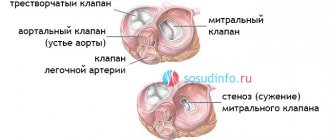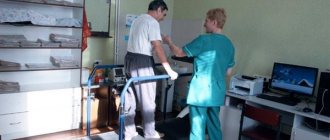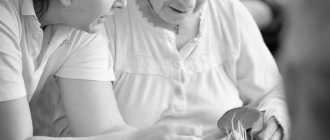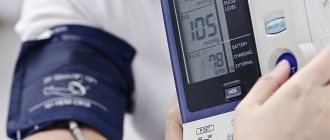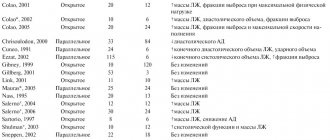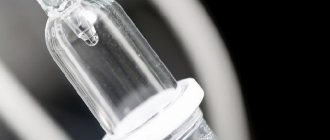Changes in heart function in old age
The heart is often called the engine in the human body. After all, this organ, only the size of a fist, is responsible for the life support of the entire body. Through the heart, blood enters every cell of the body, and with it the necessary nutrients.
Old age is characterized by changes and disturbances in the functioning of the heart muscle.
- The size of the heart increases. A common occurrence in old age is an increase in the size of the left ventricle of the heart, the walls of which thicken and begin to conduct less and less blood into the chamber. It fills up very slowly compared to previous years. Therefore, when comparing the size of the heart and its efficiency in elderly people, one can note negative dynamics compared to younger people.
- The contractility of the heart muscle decreases. By the time a person reaches 70 years of age, their heart pumps about 165 million liters of blood. When thinking about how to strengthen the heart in old age, it is worth knowing that its performance directly depends on the condition of myocardial cells, which become fewer and fewer over the years. The reason for this is the impossibility of self-renewal of cardiomycytes, in the place of which connective tissue is formed. The body tries to replace dead cells with it in order to strengthen the surviving ones. However, full compensation for the work of dead cardiomycytes cannot be achieved in this way.
- The functioning of the heart valve apparatus is disrupted. The mitral and aortic valves are the most susceptible to age-related changes, the valves of which lose their flexibility over time. Loss of elasticity, among other things, can be caused by the accumulation of calcium in the heart. As a result, heart failure occurs due to the functionality of the valve, which leads to uneven distribution of blood throughout the cavities of the heart.
- Heart rate changes. Impulses for pumping blood by the heart are generated by cells that die during the entire time a person lives in the world. In elderly people, the number of functional cells rarely exceeds 10% of the initial level, which certainly leads to arrhythmia.
We recommend
“Features of older people: psychological and physiological” Read more
Infusion therapy at the Paracelsus clinic, Sergiev Posad, Alexandrov
ATTENTION:
Online consultations with doctors (more than 18 specialties) are available.
Infusion therapy (intravenous drip)
- a method of treatment based on the introduction of solutions into the bloodstream in order to ensure the patient’s recovery or improve his condition. Depending on the clinical situation, the infusion solution should contain the appropriate active pharmaceutical ingredient.
Infusion therapy
– an integral part of the complex treatment of urgent conditions and chronic diseases of the internal organs of the human body. The doctor determines the course of infusion therapy individually for each patient.
Goals of fluid therapy
— the main goal of infusion therapy is the rapid and effective restoration of central and peripheral hemodynamics, correction of rheological parameters of the blood, acid-base and electrolyte balance, hemostasis system, removal of toxic waste products of pathogenic microorganisms and components of impaired metabolism, providing energy to the vital functions of internal organs.
How to strengthen your heart in old age with moderate exercise
Unfortunately, sick people often know more about the benefits of health. But it is always better to prevent heart problems by consciously working on strengthening your striated muscles. The best means for this will be physical exercises, which are performed taking into account certain rules.
- You should train regularly, keeping equal intervals between classes. It is better if they take place at least 2 times a week.
- The workout should last 60 minutes and include a variety of activities and intensity levels.
- It is better to do physical exercise in the fresh air. If this is not possible, there should be natural ventilation in the room where classes are held. Exercise should stimulate ventilation of the lungs. Such measures will provide the necessary aerobic load for the entire body, which allows lactic acid to be completely oxidized in the tissues, which reduces the contractility of muscles, including the heart.
- When thinking about how to strengthen the heart in old age, in addition to physical education, which has a positive effect, you should also get rid of the negative effects: smoking, lack of sleep, aggression and stress.
We recommend
“Vitamins for elderly people over 70: which ones are needed first” Read more
Not yet evening!
Unfortunately, over time, the influence of risk factors accumulates, the “engine” begins to act up and often breaks down. Coronary heart disease, heart attacks and strokes are the most common illnesses that prematurely claim the lives of people in Russia. The main victims of these diseases are men aged 45–60 years. Women experience these problems about 10 years later, after age 55.
Cardiovascular accidents do not pass without a trace. Even if a person can be saved, he often becomes incapacitated and his life is filled with various restrictions. But 50–55 years is a very young age...
What to do if you don’t want your fate to follow such a gloomy scenario, but in your youth you didn’t care too much about your body? Start taking care of him now! Change your usual lifestyle to a healthier one. Even when you reach risk age, it can save you from a lot of trouble.
What foods help strengthen the heart in old age?
- Legumes contain calcium and soluble fiber, which activate digestion and heart function.
- Lean meat (beef, chicken, turkey, rabbit).
- Fish, which, unlike meat, should be fatty: mackerel, herring, salmon and other red varieties. If you can’t buy fish often, you should supplement your diet with fish oil tablets.
- Olive oil. Helps keep cholesterol levels within normal limits.
- Oatmeal. In addition to useful vitamins and microelements, this porridge has a calming effect on the heart.
- Cottage cheese and fermented milk products, which are also rich in calcium.
- Multigrain bread. It is better to prefer rye or whole grain varieties to yeast bread made from white flour.
- Vegetables and fruits, the daily intake of which should be from 400 grams. The emphasis should be on foods rich in potassium: jacket potatoes, raisins, dried apricots, dates, banana, parsley and other greens. It is important to note that raisins are healthier than fresh grapes because, in addition to containing glucose, which is important for the heart, they do not have sugar.
- Nuts. For heart health, you should definitely eat a handful of any nuts every day: walnuts, pine nuts, hazelnuts, cashews, etc.
We recommend
“First aid for the elderly: what you need to know about it” Read more
Infusion therapy at Paracelsus Medical Center
Before intravenous infusion, a specialist from the Paracelsus Medical Center must conduct an examination, study the patient’s condition and his complaints. This allows us to exclude the presence of contraindications to placing an IV. If you have chronic pathologies that are unknown to the doctor, or allergic reactions, be sure to inform the specialist or provide the medical documentation you have on hand.
During the intravenous infusion, the nurse is nearby and monitors the patient’s well-being.
Infusion therapy allows you to quickly restore damaged mechanisms, normalize the functional activity of internal organs, cleanse the blood and the body as a whole of toxins that are formed as a result of the development of infections, drug residues, hormones and waste.
How to strengthen the heart in old age using folk remedies
Strengthening tea made from hawthorn, rosehip and sea buckthorn
Even mono-drinks made from hawthorn or pure rosehip alone can strengthen the heart muscle.
And if you brew tea from three ingredients at once, you can simultaneously nourish, tone and cleanse your blood vessels.
For a general strengthening drink, you will need dried fruits, taken in equal proportions. It is ideal if the fruits are harvested independently. But a pharmacy or market option is also suitable.
If sea buckthorn is purchased fresh or frozen, you need to squeeze the juice out of it before brewing.
For brewing, you can prepare in advance a mixture of fruits taken in equal quantities and place them for storage in a linen bag or glass jar. The components can also be stored separately, taking approximately 1.5 tsp. each of them immediately before brewing. When using the prepared mixture, you need to brew 2 tbsp. l. for 250 ml of boiling water.
After the fruits are filled with water, they need to be infused for 20 minutes and strained. You can sweeten the drink with a teaspoon of honey. The decoction should be consumed 2 times a day.
Vitamin mixture MILOC
One of the most famous general strengthening and immunomodulatory folk remedies is named after the first letters of its components: honey, raisins, lemon, nuts and dried apricots. This mixture is rich in potassium and vitamin C, which the heart needs so much. Having prepared such a remedy, you don’t have to wonder how to strengthen the heart in old age for a long time.
To prepare the mixture, you need to take 200 g of each of the listed ingredients. Bulk components can be weighed upon purchase. One large lemon weighs just about 200 g. And you will need about 3/4 cup of honey.
The type of nuts does not matter much. The ideal option would be walnuts.
At the beginning of cooking, raisins and dried apricots are poured with warm water and set aside. After the dried fruits have softened, they need to be dried on a paper towel.
Lemon is cut in half and into slices. Be sure to remove all the seeds.
All solid components should be minced through a meat grinder, honey should be added to the resulting puree and stirred thoroughly. The finished mixture is placed in a jar with a lid.
To prevent diseases and strengthen the heart, take 1-2 teaspoons of the product three times a day, half an hour before meals. The mixture can be washed down with tea.
Additionally, you can add prunes, pumpkin seeds and a spoonful of cocoa. It turns out to be a very tasty and healthy delicacy.
Viburnum with sugar or honey
Viburnum berries contain a whole range of different vitamins, which makes them popular for treating colds and other diseases.
The most valuable component in viburnum is the glycoside viburnin, which gives the berries a peculiar bitter taste. It is this element that is necessary to support the heart muscle.
The bitter taste, of course, is compensated by the beneficial properties of viburnum, but to reduce its manifestation, the berries can be poured with boiling water before consumption. Another way is to mix viburnum with honey, which will preserve all the beneficial qualities of the berry, but at the same time reduce the bitterness. In addition, this mixture is very convenient to store.
To prepare a healthy mixture, you need to wash and dry the berries, and then pass them through a meat grinder. Honey or sugar is added to the resulting slurry in equal proportions.
It is recommended to eat 1 tablespoon of this mixture several times a day.
Lemon-garlic mixture
This one is from the Bulgarian seer Vanga, who probably knew how to strengthen the heart in old age. The product helps to effectively clean blood vessels.
To prepare you will need 10 lemons, 10 heads of garlic and 1 liter of honey. The garlic needs to be peeled. The lemon is cut into slices, the seeds must be removed from the pulp. Then everything is scrolled in a meat grinder. Honey is added to the resulting puree. The finished mixture should be left for a week in a dark place, and then consumed 2 tablespoons in the morning.
We recommend
“How to choose a boarding house: we take into account all the criteria and pitfalls” Read more
Vitamins and minerals to strengthen your heart as you age
Vitamins enable older people to slow down the aging process of body cells, improve overall well-being and give them vigor.
For efficient functioning of the heart muscle, older people should consume the following vitamins:
- C (or ascorbic acid) accelerates metabolism, strengthens the myocardium and vascular walls, and perfectly resists the development of atherosclerosis;
- A (or retinol) dissolves cholesterol plaques;
- E (tocopherol) performs an antioxidant function, prevents aging, strengthens the heart and blood vessels, making them elastic;
- R (or rutin) has a strengthening effect on blood vessels, reducing permeability and bleeding;
- F (a complex of unsaturated fatty acids, including linoleic and linolenic) – is responsible for strengthening muscle tissue (including the heart), avoiding the formation of plaques in blood vessels;
- Q10 (coenzyme) – is also synthesized in the human liver, providing energy, reducing the risk of heart attack or arrhythmia;
- B1 (thiamine) ensures a rhythmic heartbeat;
- B6 (pyridoxine) – reduces the amount of lipids and cholesterol in the blood.
In modern pharmacies you can also find vitamin complexes specially designed for older people. Their regular use not only reduces the risk of heart disease, but also strengthens the entire body, including the immune system.
The following microelements will also help improve the condition of the cardiovascular system:
- Mg, helps the absorption of sodium and potassium in the blood, normalizes blood pressure, heals the myocardium and dissolves blood clots.
- Ca is an essential element for the contractility of the heart muscle.
- P is a building element of cells, which, being embedded in their membranes, transmits impulses throughout the myocardium, affecting heart contractions.
- Se – helps in the fight against free radicals that destroy blood vessels and heart tissue,
- Cr – prevents the occurrence of hypertension and heart disease.
participates in the body’s absorption of other vitamins and microelements.
Of course, the aging body and heart need nutrients and vitamins. But it is important to consider that over the years, a person’s need for these elements decreases. In addition, recent studies have shown that in the body of older people, many minerals (such as calcium) are not absorbed, accumulating on the walls of blood vessels, in joints and cartilage.
Carrying out infusion therapy
Intravenous infusions should only be carried out by a qualified specialist who is familiar with the characteristics of the administration of various substances, their combination and the possible reaction of the patient’s body. Particular attention is paid to the speed of administration of the infusion solution with dissolved agents. Trust your health only to active professionals. This will avoid adverse health consequences: hematoma, allergic reaction, pain and redness.
First, the injection site (usually the elbow) is treated with an antiseptic. The vein is prepared in the traditional way using a tourniquet and secured by tautening the skin. The needle is inserted when the hand is clenched into a fist; The tourniquet is removed when blood appears in the needle cannula. Next, the infusion system is attached to the cannula and the clamp opens, allowing the fluid to flow. The speed of the drops is adjusted depending on the doctor's recommendations.
During the procedure, a nurse monitors the process. At the end of the procedure, the clamp is closed, the needle is carefully pulled out of the vein using a cotton pad moistened with an antiseptic. Typically, the IV site is bandaged to stop bleeding.
